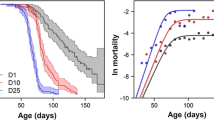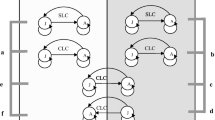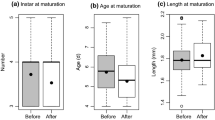Abstract
Studies of plant and animal populations have demonstrated the occurrence of multiple and mixed life history strategies such as polymodal timing of germination and emergence from dormancy. We present the results of a simulation model used to test whether between-year variance in mortality can lead to the persistence of multiple hatching strategies considered over an ecological time scale (50 years). The model is based on the general life history characteristics of a population of planktonic copepods (Diaptomus sanguineus) in Bullhead Pond, Rhode Island. Our model results demonstrate that, given a range of between-year variance in mortality, multiple strategies for timing of emergence can persist in a common environment for ecologically relevant periods of time. A qualitative test of the model comparing field estimates of mean and variance of mortality in Bullhead Pond with the region of persistence indicates that the model results are in approximate agreement with field estimates. The results suggest that variability in year-to-year selection pressures, such as predation or harsh winters, may play an important role in determining the evolution of life histories.
Similar content being viewed by others
Literature
Arthur, A. E., J. S. Gale and M. J. Lawrence. 1973. Variations in wild populations ofPapaver dubium. VII. Germination time.Heredity 30, 189–197.
Bartolome, J. W. 1976. Early rains alter range forage.Calif. Agric. 30, 14–15.
Bartolome, J. W. 1979. Germination and seedling establishment in California annual grassland.J. Ecol. 67, 273–281.
Baskin, J. M. and C. C. Baskin. 1972. Influence of germination date on survival and seed production in a natural population ofLeavenworthia stylosa.Am. Midl. Nat. 88, 318–323.
Black, J. N. and G. N. Wilkinson. 1963. The role of time of emergence in determining the growth of individual plants in swards of subterranean clover (Trifolium subterraneum L.).Aust. J. Agric. Res. 14, 628–638.
Bradshaw, W. E. 1973. Homeostasis and polymorphism in vernal development ofChaoborus americanus.Ecology 54, 1247–1259.
Braner, M. 1988. Dormancy, dispersal and staged development: ecological and evolutionary aspects of structured populations in random environments. Ph.D. thesis, Cornell University, Ithaca.
Braner, M. and N. G. Hairston Jr. 1989. From cohort data to life table parameters via stochastic modeling. InEstimation and Analysis of Insect Populations, L. McDonald, B. Manly, J. Lockwood and J. Logan (Eds), Vol. 55, pp. 81–92, Lecture Notes in Statistics. Berlin: Springer-Verlag.
Caswell, H. 1978. Predator mediated coexistence: a nonequilibrium model.Am. Nat. 112, 127–154.
Chesson, P. 1982. The stabilizing effect of a random environment.J. math. Biol. 15, 1–36.
Chesson, P. and N. Huntley. 1989. Short-term instabilities and long-term dynamics.Trends Ecol. Evol. 4, 303–308.
Cohen, D. 1966. Optimizing reproduction in a randomly varying environment.J. theor. Biol. 12, 119–129.
Cohen, D. 1968. A general model of optimal reproduction in a randomly varying environment.J. Ecol. 56, 219–228.
Cohen, D. and S. A. Levin. 1987. The interaction between dispersal and dormancy strategies in varying and heterogeneous environments. InMathematical Topics in Population Biology, Morphogenesis, and Neuroscience, Proceedings from Kyoto, 1985, E. Teramoto and M. Yamaguti (Eds), pp. 110–122. Berlin: Springer-Verlag.
DeAngelis, D. L. and J. C. Waterhouse. 1987. Equilibrium and nonequilibrium concepts in ecological models.Ecol. Monogr. 57, 1–21.
Dempster, E. R. 1955. Maintenance of genetic heterogeneity.Cold Spring Harbor Symp. Quant. Biol. 20, 25–32.
De Stasio, B. T., Jr. 1989. The seed bank of a freshwater crustacean: copepodology for the plant ecologist.Ecology 70, 1377–1389.
De Stasio, B. T., Jr. 1990. The role of dormancy and emergence patterns in the dynamics of a freshwater zooplankton community.Limnol. Oceanogr. 35, 1079–1090.
Ellner, S. 1985. ESS germination strategies in randomly varying environments. I. Logistic-type models.Theor. Popul. Biol. 28, 50–79.
Garbutt, K. and J. R. Witcombe. 1986. The inheritance of seed dormancy inSinapsis arvensis L.Heredity 56, 25–31.
Gillespie, J. H. 1973. Natural selection with varying selection coefficients—a haploid model.Genet. Res. 21, 115–120.
Hairston, N. G., Jr. 1987. Diapause as a predator-avoidance adaptation. InPredation: Direct and Indirect Effects on Aquatic Communities, W. C. Kerfoot and A. Sih (Eds), pp. 281–290. New England University Press.
Hairston, N. G., Jr. 1988. Interannual variation in seasonal predation: Its origin and ecological importance.Limnol. Oceanogr. 33, 1245–1253.
Hairston, N. G., Jr, W. E. Walton and K. T. Li. 1983. The causes and consequences of sex-specific mortality in a freshwater copepod.Limnol. Oceanogr. 28, 935–947.
Hairston, N. G., Jr and W. R. Munns Jr. 1984. The timing of copoped diapause as an evolutionarily stable strategy.Am. Nat. 123, 733–751.
Hairston, N. G., Jr and E. J. Olds. 1984. Population differences in the timing of diapause: adaptation in a spatially heterogeneous environment.Oecologia (Berlin)61, 42–48.
Hairston, N. G., Jr and E. J. Olds. 1986. Partial photoperiodic control of diapause in three populations of the freshwater copepodDiaptomus sanguineus.Biol. Bull. 171, 135–142.
Hairston, N. G., Jr and E. J. Olds. 1987. Population differences in the timing of diapause: a test of hypotheses.Oecologia (Berlin)71, 339–344.
Hairston, N. G., Jr and B. T. De Stasio, Jr. 1988. Rate of evolution slowed by a dormant propagule pool.Nature (London)336, 239–242.
Hairston, N. G., Jr, T. Dillon and B. T. De Stasio, Jr. 1990. A field test of the cues of diapause in a freshwater copepod.Ecology 71, 2218–2223.
Hairston, N. G., Jr. and T. Dillon. 1990. Fluctuating selection and response in a population of freshwater copepods.Evolution 44, 1796–1805.
Harper, J. L. 1977.Population Biology of Plants. New York: Academic Press.
Hildrew, A. G. 1985. A quantitative study of the life history of a fairy shrimp (Branchiopoda: Anostraca) in relation to the temporary nature of its habitat, a Kenyan rainpool.J. Anim. Ecol. 54, 99–110.
Hilu, K. W. and J. M. de Wet. 1980. Effect of artificial selection on grain dormancy inEleusine (Gramineae).Sys. Bot. 5, 54–60.
Howell, N. 1981. The effect of seed size and relative emergence time on fitness in a natural population ofImpatiens capensis Meerb. (Balsaminaceae).Am. Midl. Nat. 105, 312–320.
Kalisz, S. 1986. Variable selection on the timing of germination inCollinsia verna (Scrophulariaceae).Evolution 40, 479–491.
Kankaala, P. 1983. Resting eggs, seasonal dynamics, and production ofBosmina longispina maritima (P. E. Müller) (Cladocera) in the northern Baltic proper.J. Plank. Res. 5, 53–69.
Karabin, A. 1978. The pressure of pelagic predators of the genusMesocyclops (Copepoda, Crustacea) on small zooplankton.Ekol. Polska 26, 241–257.
Krylov, P. I. 1988. Predation of the freshwater cyclopoid copepodMegacyclops gigas on lake zooplankton—functional response and prey selection.Arch. Hydrobiol. 113, 231–250.
Leinaas, H. P. and E. Bleken. 1983. Egg diapause and demographic strategy inLepidocyrtus lignorum Fabricus (Collembola; Entomobrydiae).Oecologia (Berlin)58, 194–199.
Levin, S. A., D. Cohen and A. Hastings. 1984. Dispersal strategies in patchy environments.Theor. popul. Biol. 26, 165–191.
Livdahl, T. P. 1982. Competition within and between hatching cohorts of a treehole mosquito.Ecology 63, 1751–1760.
Marks, M. and S. Prince. 1981. Influence of germination date on survival and fecundity in wild lettuceLactuca serriola.Oikos 36, 326–330.
Nisbet, R. M. and W. S. C. Gurney. 1982.Modelling Fluctuating Populations. New York: John Wiley.
Partridge, L. and P. H. Harvey. 1988. The ecological context of life history evolution.Science 241, 1449–1455.
Phillippi, T. and J. Seger. 1989. Hedging one's evolutionary bets, revisited.Trends Ecol. Evol. 4, 41–44.
Press, W. H., B. P. Flannery, S. A. Teukolsky and W. T. Vetterling. 1986.Numerical Recipes. Cambridge, U.K.: Cambridge University Press.
Rice, K. J. 1987. Evidence for the retention of genetic variation inErodium seed dormancy by variable rainfall.Oecologia (Berlin)72, 589–596.
Seger, J. and H. J. Brockman. 1987. What is bet-hedging?Oxford Surv. Evol. Biol. 4, 182–211.
Silvertown, J. W. 1984. Phenotypic variety in seed germination behavior: the entogeny and evolution of somatic polymorphism in seeds.Am. Nat. 124, 1–16.
Silvertown, J. W. 1985. When plants play the field. InEvolution: Essays in Honor of John Maynard Smith, P. J. Greenwood, P. H. Harvey and M. Slatkin (Eds), pp. 143–153. Cambridge, U.K.: Cambridge University Press.
Stearns, S. C. 1977. The evolution of life history traits: a critique of the theory and a review of the data.Ann. Rev. Ecol. Syst. 8, 145–171.
Tauber, M. J., C. A. Tauber and S. Masaki. 1986. Seasonal adaptations of insects. Oxford, U.K.: Oxford University Press.
Tuljapurkar, S. 1990. Delayed reproduction and fitness in variable environments.Proc. Natl. Acad. Sci., U.S.A. 87, 1139–1143.
Venable, D. L. 1989. Modeling the evolutionary ecology of seed banks. InEcology of Soil Seed Banks, M. A. Leck, V. T. Parker and R. L. Simpson (Eds), pp. 67–87. New York: Academic Press.
Venable, D. L. and L. Lawlor. 1980. Delayed germination and dispersal in desert annuals: escape in space and time.Oecologia 46, 272–282.
Waldbauer, G. P. 1978. Phenological adaptation and the polymodal emergence patterns of insects. InEvolution of Insect Migration and Diapause, H. Dingle (Ed.), pp. 127–144. Berlin: Springer-Verlag.
Waldbauer, G. P. and J. G. Sternburg. 1973. Polymorphic termination of diapause by cecropia: genetic and geographical aspects.Biol. Bull. 145, 627–641.
Watras, C. J. 1980. Subitaneous and resting eggs of copepods: relative rates of clutch production byDiaptomus leptopus.Can. J. Fish. Aquat. Sci. 37, 1579–1581.
Wilson, M. S. 1959. Free-living copepoda. InFresh-water Biology, W. T. Edmondson (Ed.), pp. 735–861, 2nd edition. New York: John Wiley.
Yodzis, P. 1977. Harvesting and limiting similarity.Am. Nat. 111, 833–843.
Author information
Authors and Affiliations
Rights and permissions
About this article
Cite this article
De Stasio, B.T., Hairston, N.G. Environmental variability and the persistence of multiple emergence strategies. Bltn Mathcal Biology 54, 313–334 (1992). https://doi.org/10.1007/BF02464836
Received:
Revised:
Issue Date:
DOI: https://doi.org/10.1007/BF02464836




